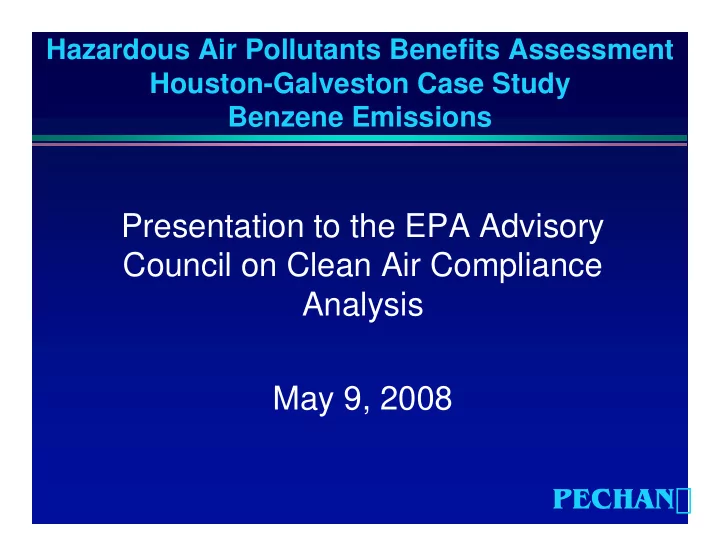

Hazardous Air Pollutants Benefits Assessment Houston-Galveston Case Study Benzene Emissions Presentation to the EPA Advisory Council on Clean Air Compliance Analysis May 9, 2008 PECHAN
Analytical Approach Scenario Development Emissions Inventory Air Quality Modeling Exposure Modeling Health Effects Modeling PECHAN
Charge Question #2: Emissions Estimation Does the Council agree with the emission estimation approaches? » Use of National Emissions Inventory » Point, Nonpoint, On-road and Non-road approaches » Attached Garages Any questions? PECHAN
Emission Estimation Point and Non-Point Sources » 1990 NEI for HAPs used for base year (1990) emissions estimates » Without-CAAA: 1990 NEI for HAPs used as base year file for estimating emissions for 2000, 2010, and 2020 » With-CAAA: 2002 NEI used for 2000 and as the base year emissions file for 2010 and 2020 emission estimates » Non-point sources also includes aircraft, locomotives, commercial marine vessels PECHAN
Emission Estimation (Cont’d) On-Road Sources » Generated seasonal hourly link-level (i.e., roadway segment) emissions data » VMT estimates from HGAC and TTI for 2005 » Emissions factors from MOBILE 6.2 Non-Road Sources (sources in NONROAD model only) » Product of benzene speciation factors and VOC emissions estimates » Speciation factors and fuel data inputs – EPA’s NMIM » VOC emissions from EPA’s 2004 NONROAD model PECHAN
Base Year Point Source Data Set Selection EPA National Emission Inventory Texas AQS Study (1990, 2002) (2000) Pollutants: Criteria plus HAPs Criteria plus speciated VOC Time Periods: Annual, ozone season daily Hourly emissions for August-September 2000 episode Attributes Considered in Evaluation: Pollutant coverage Time period(s) Control device information Ability to be used in forecasts PECHAN
Key On-Road Vehicle Modeling Methods Link-level data files from Aug-Sept episode (hourly) » Weekday » Friday » Saturday » Sunday Adjustments made: » Four seasons » Vehicle type allocation » Typical day (weighted average) » Our analysis years PECHAN
Attached Garage Emissions Nonroad sources » Residential lawn and garden » Recreational non-road vehicles – Exhaust – Evaporative – Refilling On-road vehicles (light-duty) » Resting loss » Diurnal loss » Starts PECHAN
Emission Estimation - Results Houston-Galveston Benzene Emissions Summary (tons per year [tpy]) 2000 2000 2010 2010 2020 2020 Sector 1990 without-CAAA with-CAAA without-CAAA with-CAAA without-CAAA with-CAAA Point/Nonpoint 5,409 6,532 1,230 6,699 1,258 7,702 1,440 Nonroad 740 900 567 1,127 354 1,351 360 Onroad vehicles 2,375 1,541 762 1,449 328 1,988 282 Total 8,524 8,973 2,559 9,275 1,940 11,041 2,082 PECHAN
CAAA-Associated Houston-Galveston Benzene Emission Reductions On-Road All Sectors Vehicles Combined 1990-2000 68% 71% 2010 86% 79% 2020 88% 81% PECHAN
Key CAAA Programs in Reducing Houston- Galveston Area Benzene by Decade Sector 2000 2010 2020 Point/Nonpoint MACT MACT ? 1-hour O 3 1 and 8-hour measures O 3 measures Nonroad Phase 1 SI SI engine SI engine engine standards standards standards Onroad Vehicles Federal RFG Tier 2 and Tier 2 and Fuel S limits Fuel S limits Tier 1/NLEV standards PECHAN
Percentage Contributions to Houston-Galveston Area Benzene Emissions with CAAA Scenario Sector 1990 2000 2010 2020 Point/Nonpoint 63% 48% 65% 69% Nonroad 9% 22% 18% 17% Onroad Vehicles 28% 30% 17% 14% PECHAN
How does this study compare with other recent Houston-Galveston studies? PECHAN
Houston Onroad Emissions (tpy) by Inventory 3500 3000 2500 LEGEND 2000 NATA (county-level) Pechan (link-level) 1500 Houston 1996 (links) 1000 500 0 1990 NEI 1990 1996 1999 2000 2000 2002 2010 2010 2010 2020 2020 2020 Houston Houston NATA Houston Houston Draf t NEI MSAT w ith w /o MSAT w ith w /o w ith w /o CAA CAA CAA CAA CAA CAA PECHAN
On-Road Vehicle Emissions Differences – This Study vs. Others Most Important Least Important Factors Factors » Registration » Vehicle speeds distributions » I/M program » Fuel benzene assumptions summer levels » VMT fractions » Recent reductions from control programs PECHAN
Uncertainties Baseline emissions inventories Categories incompletely characterized » Portable fuel containers » Tank and hose permeation MSAT rule emission reductions Vehicle cold temperature start effects Future growth rates and control factors PECHAN
Summary and Conclusions Benzene emissions have been reduced substantially by CAAA provisions since 1990 For onroad and nonroad vehicles – further reductions are expected in future years Future changes in point/nonpoint source benzene in Houston-Galveston area depend on control approaches for 8-hour ozone Emission contribution by sector change dramatically by year PECHAN
Recommend
More recommend